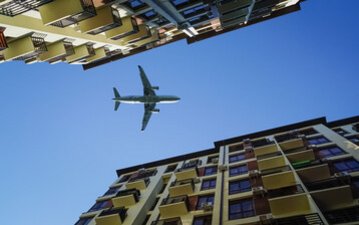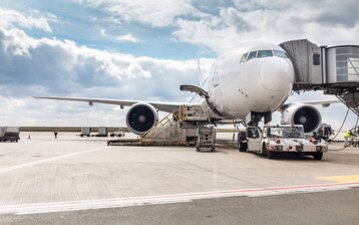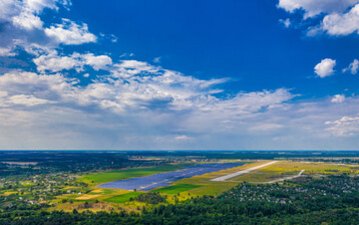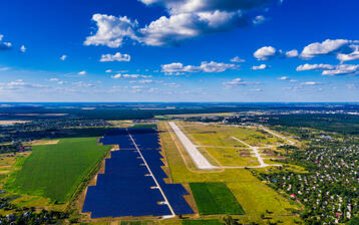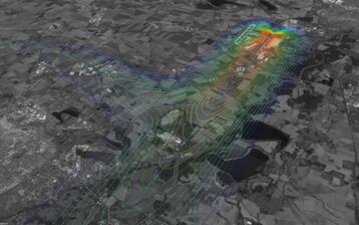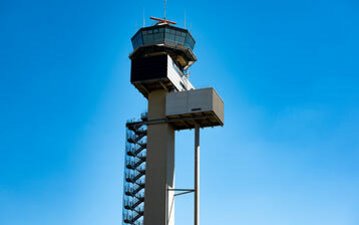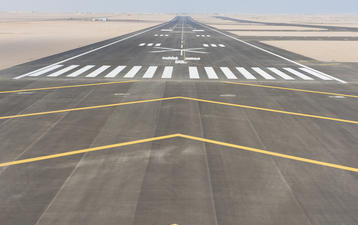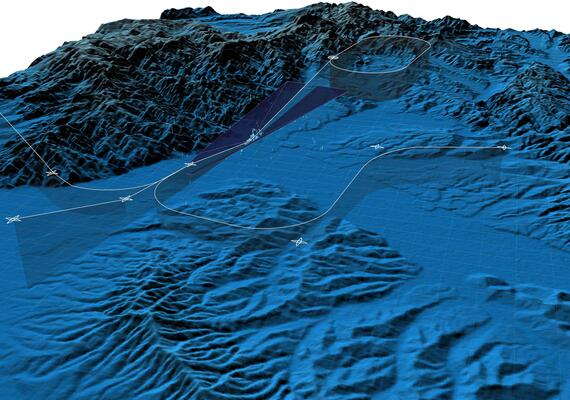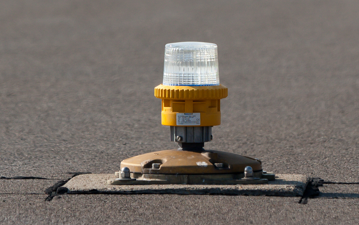Achieving environmental sustainability and net zero goals is of significant increasing importance to all relevant aviation stakeholders. Whether airport operators, CAAs, ANSPs or airlines: Fostering decarbonization and electrificaton at airports, being compliant with environmental regulations, improving the noise situation around airports or increasing fuel efficiency of flight operations often determines the daily business of our clients dealing with environmental issues.
Within our focus areas Renewables at Airports, Climate Action, Aircraft & Airport Noise, and Emissions & Air Quality we provide our customers with our many years of experience in dealing with legal regulations, international standards, scientific methods and industry best-practices, supported by state-of-the-art software tools and methods.
A balanced approach to achieving sustainability and improving environmental protection at and around airports requires the consideration of many interests and sub-areas. In order to achieve maximum acceptance of environmental and sustainable protection measures by all stakeholders involved, airsight works with an interdisciplinary team on tailor-made and site-specific solutions towards environmental sustainability in aviation.

Do you have a project that you'd like to discuss with us?
Send us a message, we will review your request and get back to you!

Renewables at Airports
Many airport operators are seeking for a safe and independent energy supply powered by renewable energies. Be it sustainable building cooling/heating or charging facilities for electric aircraft, eVTOL or GSE: The electrification of airports require large amounts of green energy to be available on site. Using renewable energy sources at the airport seems to be obvious, however, placing a solar systems close to aircraft movement areas or wind turbines in the vicinity of airports might be challenging from a safety and regulatory compliance perspective. Solar systems are also increasingly being installed on roofs around airports, making it essential to analyze glint and glare effects for pilots or air traffic control.
The solar power yield at airports can be massively increased if unconstructed spaces near aircraft movement areas are used. However, placing a solar farm near aircraft movement areas or installing conventional roof-mounted systems close to airports is challenging from a safety and compliance perspective. Depending on the site characteristics, a large number of requirements must be observed for the planning and approval of a photovoltaic systems at airports from an aeronautical engineering perspective, such as glint and glare assessment (acc. FAA guidelines), safety clearances on ground, obstacle clearances, impact on CNS and MET facilities but also the assessment of the impact of PV systems on emergency response or wildlife behaviour. Learn more on our services on solar PV systems at airports.
Wind energy is one of the most sustainable alternatives to burning fossil fuels and becoming more and more popular. However, the increasing size of modern wind turbines can create hazards to aviation, especially when placed too close to aerodromes and flight routes. airsight supports developers as well as aviation authorities with an independent assessment of the potential impact on aviation hazards created by wind turbines.
Large wind turbines may have a significant impact on safety of aircraft operations. airsight assists to resolve complex wind farm planning issues related to aviation:
- Feasibility checks to identify potential restrictions and height limitations at an early planning phase
- Aeronautical studies of wind turbines from a regulatory and safety perspective
- Impact assessment of Communication, Navigation and Surveillance (CNS) facilities
- Development of marking and lighting concepts
- airsight has been entitled as authorized entity to verify aircraft detection lighting systems (ADLS)
Like to know more? Click here
The energy transformation will only succeed if all available natural resources are used for energy generation. By diversifying the energy supply beyond wind and solar, the airport or airfield could thus become an energy harvester and supplier for the entire region. In addition to energy from wind and sun (which fluctuate seasonally and with time of day), geothermal energy can be used to provide air conditioning for buildings and terminals. And not only from great depths below the airport, but also as so-called near surface geothermal energy systems just below concreted or asphalted apron and taxiway areas.
Whether grass clippings, bio trash or other organic materials, biomass generated at airports and airfields can be used to generate electricity and thermal energy. Since such facilities are often located within the airport and close to aircraft movement areas, extensive proof of regulatory compliance, safety assessments, construction planning and land use planning, and integration into existing grids are required during the planning and approval phase.
We support airports, energy provider and system suppliers already during early planning stages up to authority approval with our profound knowledge in aviation regulations, safety assessments, impact analysis on operations and implications of construction works with airport operation.

Climate Action
The climate crisis does not stop at aviation, and so various stakeholders have to deal with the challenges, but also with the potentials of climate change. Whether it’s achieving net-zero carbon emissions before 2050, addressing challenges arising from new aircraft technologies, building solar farms at airports or improving resilience to the future impacts of climate change on airport operations or infrastructure: airsight provides cutting-edge knowledge and specialized know-how supporting airports to become more sustainable, efficient and competitive in the future.
Climate change is accompanied by an increase in extreme (adverse) weather events such as heavy rain, storms, heat waves or desertification. Airports are already experiencing the consequences and intensity of such events through increase in flight delays and cancellation, operation interruptions and damage to key airport infrastructure.
To be prepared for the future, airports must understand the risks and initiate adaptation measures for existing and new infrastructure. Critical operations and key infrastructure must be designed to be as resilient as possible to climate change.
Through its in-depth knowledge in airport planning and design but also through profound knowledge in risk and safety assessment, airsight is offering support for airports seeking to strengthen their resilience against climate changerelated extreme weather events:
- Impact analysis and identification of climate change related impacts on airport operation, infrastructure and equipment
- Analysis of historical high-fidelity weather data (e.g. NASA GMAO MERRA-2) and future climate forecasts
- Analysis and assessment of the relationship between the probability of severe weather occurrence and the severity of damage to airport elements and processes based on ICAO/EASA standards and regulation
- Conduction of detailed climate assessments, e.g. flood risk assessments
airsight supports its clients in the planning and implementation of new emission-reducing technologies, systems and processes at airports. In light of the ambitious net zero emission targets set by airports, there is a pressing need for the rapid and efficient implementation of measures aimed at reducing Scope 1-3 emission at airports (with focus on infrastructure, equipment and operations), such as:
- Infrastructure adjustment (due to implementation of solar farms or introduction of new operational procedures, such as sustainable taxiing)
- Introduction of low-emission equipment, such as electric or hydrogen vehicles, e-GSE
- Improving operational procedures, such as single/reduced engine taxi, sustainable taxiing with TaxiBot etc.
As part of feasibility studies and decarbonization roadmapping with focus on airside-processes of airports, airsight assists clients in overcoming the challenges and barriers associated with airport decarbonization efforts through its expertise in airport planning & operations, compliance, safety, and efficiency analysis. We have already supported our clients in the following areas:
- Evaluation and feasibility study for the implementation of sustainable taxi modes (STX)
- Development of Concept of Operations (CONOPS)
- Implementation planning for eGSE
- Financial analysis
- Stakeholder engagement
airsight supports airports, ANSPs or CAAs in the impact and feasibility analysis of emerging (fuel) technologies on masterplanning & infrastructure, operations and safety with profound experience in airport planning, operations, safety assessments and financial analysis. Our team of aerospace engineers closely follows the latest trends and developments in sustainable solutions for aviation and its effects for airports and aviation stakeholder, such as:
- Roadmapping for the ramp up of hydrogen, SAF or green electricity at airports
- Sustainable energy production and associated challenges and potentials for airports (e.g. renewables at airports)
- Required ground infrastructure (e.g. charging stations) for hydrogen and electric aircraft and ground vehicles (GSE & busses)
- Support of approval planning through compliance checks, safety assessments and CONOPS development
If you have a project or idea that you would like to discuss with us, please feel free to contact us via our website.
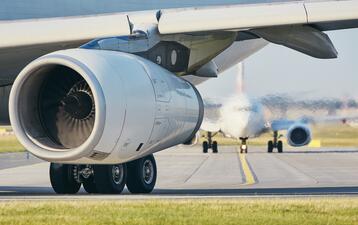
Aircraft and Airport Noise
We assist our customers in analysing the current status-quo related to aircraft noise, developing noise mitigation strategies, performing noise modeling and assessments (e.g. with AEDT) and validation tasks based on international/national standards and regulations, scientific methods and industry best practice. Not only for fixed-wing aircraft but also for helicopters and new technologies like eVTOL's or UAS!
Assessment and optimization of flight procedures to meet eco-efficient targets with maximum acceptance for involved stakeholders
airsight offers the evaluation and environmental assessment of flight procedures (e.g. departures and approaches) with regards to aircraft noise, fuel efficiency and pollutant emission. As increased fuel efficiency goes hand in hand with reduced pollutant emissions, our goal is to find the optimum for eco-efficiency (noise and emissions) of flight procedures, meeting maximum acceptance for all involved stakeholders (airport and aircraft operators, ANSPs, authorities and the local communities).
Stakeholders will benefit from the successful implementation of eco-efficient flight procedures, by less noise complaints from communities, lower fuel costs and increased efficiency. The close cooperation with airsights Flight Procedure Design experts guarantees the consideration of state-of-the art flight procedures and technologies.
Our services along the environmental assessment include
- Design and optimization of noise abatement and fuel-efficient flight procedures according to ICAO PANS-OPS (Doc 8168) with the use of performance-based navigation (PBN), continuous climb and descent operations (CCO/CDO) and noise abatement departure procedures (NADP)
- Consideration of airspace capacity and ATM/ATC capability
- Analysis of flight tracks and vertical profiles (e.g. based on Mode-S/MLAT/ADS-B/radar data) and airport noise measurement data
- Aircraft noise calculation and assessment based on state-of-the art software tools (e.g. AEDT, SoundPlan), approved models (e.g. ECAC Doc 29) and assessment practices
- Calculation of aircraft performance and engine emissions acc. approved methods (e.g. BADA)
- Development of operational concepts and noise-related restrictions
- Validation of flight procedures using certified full flight simulators
- Stakeholder support within the framework of EUROCONTROL Collaborative Environmental Management (CEM)
airsight performs aircraft and helicopter noise calculation, mapping as well as associated tasks (e.g. data aggregation, quality assurance) for a variety of use cases, according to legal requirements by using certified, professionally recognised software tools:
- Modelling and mapping of aircraft and helicopter noise w.r.t. to national/European legislation (e.g. acc. noise directive 2002/49/EC)
- Noise calculation in accordance with ECAC Doc. 29
- Airplane and helicopter noise modeling in the context of environmental impact assessments (case studies)
- Development of noise action plans and airport sustainability plans with regard to aircraft noise
- Assessment of noise impact acc. scientific methods (%A, %HA, %AWR)
- Mapping and data visualization (web-based, interactive)
- Noise calculation tools: Aviation Environmental Design Tool (AEDT), SoundPlan
In view of airsight’s recent consulting activities for Urban Air Mobility (UAM) we perform initial noise evaluation studies of future eVTOL/UAS operation. The noise evaluation will support the decision making process for vertiport planning and flight procedure design. Since this area of noise assessment is subject to constant scientific discovery and innovation, we maintain close relationships with scientifically recognized research institutions. Our services comprise:
- Modelling and mapping of eVTOL/UAS-based noise
- Assessment of noise impact acc. scientific methods (%A, %HA, %AWR)
- Noise mapping
- Data acquisition as input for noise modeling & mapping (e.g. population data, flight plans, flight tracks)
airsight assists airports in the systematic review and analysis of airport noise measurement data, identification of irregularities and root cause analysis:
- Data acquisition, correlation of relevant data, analysis of
- Noise measurement data
- Flight progress data
- (Mode-S/ADS-B/radar data)
- Weather data
- Aircraft movement data (flight plans)
- Preparation of noise measurement data for noise reports (as required by national legislation) and for public relation
- Development of noise management plans based on noise measurement data and aircraft noise modelling
- Data visualizsation (web-based, interactive)
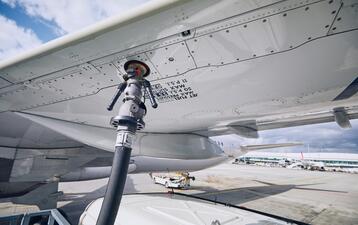
Emissions & Air Quality
airsight uses validated aircraft performance models to calculate fuel consumption and fuel-related emissions (fuel burn, CO2 & non-CO2) of aircrafts during flights in the TMA and while taxiing on the ground. This allows existing inefficiencies to be quickly identified and corrected, reducing fuel consumption, thus reducint the carbon footprint and improving local air quality (LAQ) around the airport. We are also helping airports redesign the environmental charging system to encourage more fuel-efficient and less noisy aircraft types while maintaining cost structures and revenue.
airsight analyzes fuel-based emissions during taxiing and flight operation in the TMA as part of airport emission inventory. We identify possible bottlenecks in the flight procedure system and optimize it w.r.t to fuel efficiency. This will help both airspace users to lower their fuel costs as well as airport operators to improve the local air quality and lower the carbon footprint. In addition, changes in the airport infrastructure and taxiway layout can be assessed rapidly in terms of fuel consumption, thus fostering acceptance by the airlines. The feasibility of operational procedures (e.g. single-engine taxi) also depends on potential fuel savings, which we can also analyze. Among other, our analysis is based on:
- Aviation Environmental Design Tool (AEDT)
- Base of Aircraft Data (BADA) based performance modelling, ICAO Aircraft Engine Emissions Database and methods enabling the calculation of fuel-based emission types (CO2 & Non-CO2)
- Validation of results in certified full flight simulators
We will support airport operators in evaluating and redesigning their current environmental charging system. In doing so, we will identify inequities and system constraints that result in lower fees for noisier and less fuel-efficient aircraft. Then, reclassifying the fee system will encourage quieter and lower-emission aircraft types, reduce community noise complaints, and improve air quality, while maintaining or increasing charges revenues. Our services include:
- Development of an innovative airport charge system which pays account to fuel-efficient and quiet aircraft types
- Simulation of the new charge system based on historic flight track data with the inclusion of aircraft noise and emission modelling
- Noise measurement data analysis
- Fleet and aircraft mix analysis w.r.t. to certification requirements acc. ICAO Annex 16 Vol.1 (Noise) and Vol.2 (Aircraft Engine Emissions)

